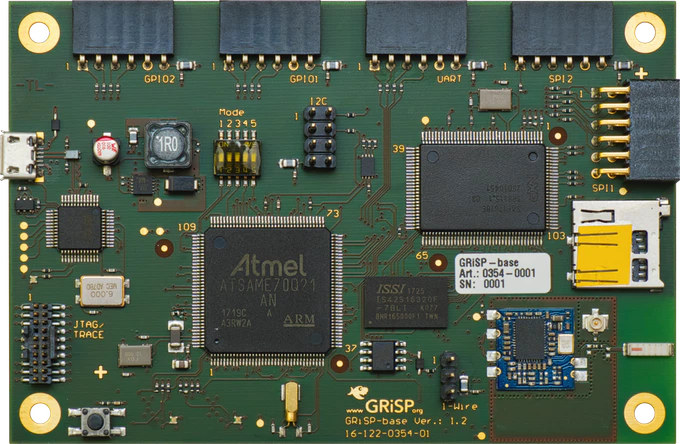Erlang is described as a programming language used to build massively scalable soft real-time systems with requirements on high availability, and used in telecoms, banking, e-commerce, computer telephony and instant messaging. Elixir is a dynamic, functional language designed for building scalable and maintainable applications that leverages the Erlang VM, known for running low-latency, distributed and fault-tolerant systems.
Elixir is used in many types of applications from higher-level web development to the embedded software domain, and Peer Stritzinger designed GRiSP board especially for the latter in 2017. He’s now back with GRiSP 2 featuring an NXP i.MX 6ULL SoM running Linux and RTEMS (Real-Time Executive for Multiprocessor Systems) RTOS.

GRiSP 2 board is comprised of a system-on-module and baseboard with the following specifications:
- System on Module
- SoC – NXP iMX6UL Arm Cortex-A7 @ 696 MHz, 128 KB L2 cache, with TRNG, Crypto Engine (AES/TDES/SHA), Secure Boot
- Memory – 128 MB DDR3 DRAM
- Storage – 4 GB eMMC flash, 4 KBit EEPROM
- Integrated power management
- Baseboard
- External Storage – MicroSD Socket
- Networking – Wi-Fi 802.11b/g/n, 100 Mbit/s Ethernet port with support for IEEE 1588
- Expansions
- 3-pin Dallas 1-Wire connector
- 1x Digilent Pmod compatible I²C interface
- 2x Digilent Pmod Type 1 interfaces (GPIO)
- 1x Digilent Pmod Type 2 interface (SPI)
- 1x Digilent Pmod Type 2A interface (expanded SPI with interrupts)
- 1x Digilent Pmod Type 4 interface (UART)
- Misc – 2x RGB LEDs, 5 DIP switches, Reset Key
- Debug & Power Supply
- Serial port via Micro USB for console (Erlang Shell or RTEMS Console)
- On-board JTAG debugger via Micro USB
- JTAG / Trace connector for external debuggers
- Power supply via Micro USB connector
- Only one USB cable needed for power, console and on-board JTAG
- Dimensions – TBD
They have not published any photos of the GRiSP 2 board, and even in the video they only show the original GRiSP board, except for the GRiSP 2 drawing in the video’s thumbnail.
Improvements listed for GRiSP 2 include:
- Real bare-metal Erlang using the RTEMS RTOS
- Support for Elixir via Nerves and Linux
- More CPU power for better peak performance and enhanced power efficiency
- Better booting capabilities, aiming at ultra-fast boot time
- Ethernet port for more network configuration choices
- Overall improved IO throughput
- More modular design to ease the move from development to production
- Improved tooling
- Complete Erlang project backward compatibility
GRiSP 2 project launched on Kickstarter a few weeks ago with a 15,000 Euros funding target, and they’ve raised close to 10,000 Euros at the time of writing. Pledges start at 179 Euros for one GRiSP 2 board with shipping adding 5 to 10 Euros. The board will apparently only ship to Europe, as the rest of the world does not have any shipping option, and you’d need to wait at least until around October 2019 to get the board, provided there aren’t any major issues during development. More details may be eventually found on GRiSP website and Github account.
Thanks to Onebir for the tip.

Jean-Luc started CNX Software in 2010 as a part-time endeavor, before quitting his job as a software engineering manager, and starting to write daily news, and reviews full time later in 2011.
Support CNX Software! Donate via cryptocurrencies, become a Patron on Patreon, or purchase goods on Amazon or Aliexpress





I would be really curious to hear the stories of anyone who finds this board useful. They’re clearly a market segment I know nothing about. Anyone?
Yeah, that’s what I was afraid of.